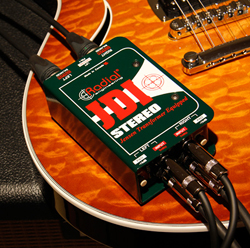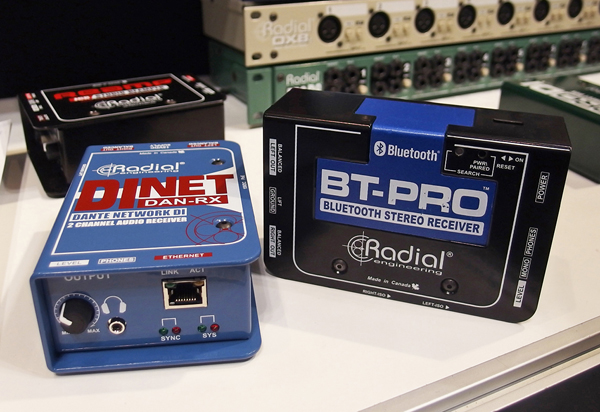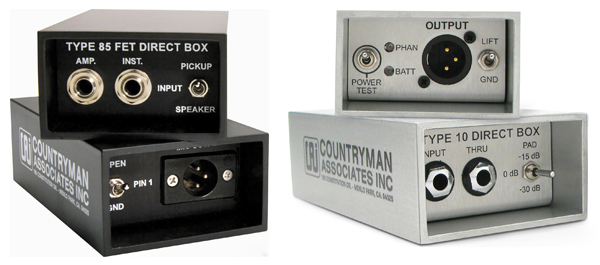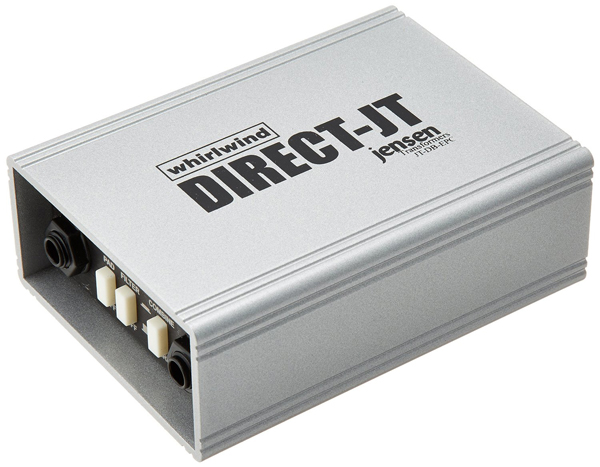
Getting Active
While the frequency response of passive DIs is nearly flat for active sources, passive sources with weak signals and high impedance can produce weak signals that require a lot of preamp gain and become colored when used with a passive direct box.
Buffering a high-impedance passive input with an active DI is like giving that source its own local preamp and line driver before it gets to the mixer.
Piezoelectric transducers require a very high input impedance load to sound correct, and the transformers in passive DIs don’t present a high enough impedance load for these sources.
The rule of thumb is to match output impedance to input impedance that’s up to 10 times higher. Fidelity is maximized when load impedance is significantly larger than the source.
The iconic and ageless black anodized aluminum Countryman Type 85 active direct boxes were designed to be “pin 3 hot” by Carl Countryman prior to AES declaring “pin 2 hot” an international standard. This matters if the Type 85’s signal is being combined with a mic on the same instrument or its speaker cabinet, and it also matters if the Type 85 is being used on a stereo source and combined with a second DI of another make.
Carl pointed out to me many years ago that I was welcome to open my Type 85 and reverse its polarity with a soldering iron. However, he added that I should also clearly mark it, since its polarity would be the reverse of the majority of the thousands of other Type 85 DIs manufactured over the course of three decades.
Countryman’s newer, silver Type 10 active direct box is designed to the current “pin 2 hot” standard employed by all other DIs and electronics today. Two green LED indicators confirm battery voltage and phantom power with the flip of a momentary switch. In addition to the -30 dB pad “speaker” position on the instrument/speaker switch, the Type 10 adds a second pad and simply labels the pad switch -15/-30 dB.
Most importantly, like the Type 85, its input impedance is 10 megohms without the pad, matching it to high-impedance sources like Piezo pickups; however, with the pads engaged, the input impedance is 10 kilohms to better mate with line- and speaker-level sources.
Radial recently released the PZ-DI, which has 3-way adjustable input impedance. Its ultra-high 10 megohm impedance compensates for the harsh tone that plagues Piezo pickups. A 1 megohm position provides the impedance commonly found on active DIs. It also has an adjustable high-pass filter and a 3 kHz low-pass filter for smoothing active instruments.
The PZ-DI’s 220 kilohm setting warms up the tone of magnetic pickups to provide the tone of a tube amplifier. Magnetic pickups used in most electric guitars and basses are inductive and highly resistive due to the sheer amount of wire windings. An input impedance that’s too low can cause HF roll-off and a dullness or lack of sustain.
High Level
Direct boxes have been used with speaker level sources for many years, though there is a strong aversion to any DIs by many electric players. The Countryman Type 85 has always had a switch with a “speaker” position that’s a 30 dB pad, as does the Type 10, (and the Radial JDI), but they can’t be used without a speaker cabinet (or other load) to soak up most of a guitar amp’s power.
The isolation and consistency of speaker-level DIs allows the warmth of tube amps to be mixed in without adding the stage wash of loud gigs. Passive speaker level “Red Box” DIs have been employed for years by heavy metal bands whose engineers want that tube “crunch,” often gaffe-taping them to Marshall guitar heads and combining them with miked cabinets to add dimensionality to 3- or 4-person bands.

The new Radial JDX-48 is an active speaker-level direct box that filters both the amp’s output and the back EMF impulse from the speakers. Its emulation is a compromise between a closed-back 4×12 and an open-back 2×12 cabinet. It also provides bass extension and handles 300 watts for SVT applications.
In late breaking news, Radial has also added two direct boxes to its line for the digital age. The new DI-NET is a Dante-enabled DI in a transmit (TX) version, with 1/4-inch, RCA and stereo 3.5 mm input jacks, as well as an RX with two male XLR and local mini-TRS headphone monitoring. Even more exciting is the new BT-PRO Bluetooth DI that allows reception up to 65 feet and also has local mini-TRS headphone monitoring.
Mark Frink is a long-time touring engineer who’s currently working with the Jacksonville Symphony Orchestra and available for a summer tour.


